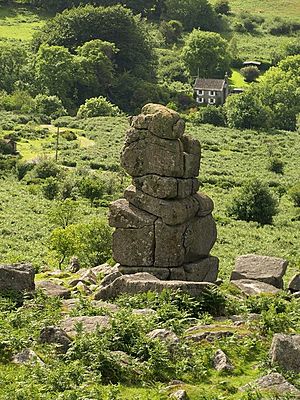Bowerman's Nose facts for kids
Bowerman's Nose is a famous stack of weathered granite rocks on Dartmoor, in Devon, England. It stands about 21.5 feet (6.5 meters) high. This amazing rock formation is located on the northern slopes of Hayne Down, close to the village of Manaton. It's the hard, strong core of what used to be a larger tor, with smaller rocks around its base that have broken off over many years.
What People Thought About It
For a long time, people wrote about Bowerman's Nose. Some early writers even made it sound much taller than it actually is, saying it was 40 or 50 feet high! They also often thought it was a very old, special object that people used to worship.
For example, in the 1820s, a writer named N. T. Carrington described it as a "Granite God." He imagined people bowing down to it long ago. Another writer, Samuel Rowe, thought it looked like the giant statues on Easter Island. He even said it looked like a "Hindoo idol" sitting down when seen from higher ground.
By the late 1800s, some people started to doubt these ideas. They realized it wasn't a god or an idol. With a bit of imagination, you can see a human-like face in the rocks. One writer joked that if the top part was its nose, it wasn't very pretty! Others thought the top part looked like a cap pushed back on a face.
Where Did the Name Come From?
The name Bowerman's Nose has an interesting history. Some people used to think it came from old Celtic words meaning "the great stone." However, this idea was later shown to be incorrect because of how the words would have been put together.
Another idea is that Bowerman was a hunter who lived nearby a long time ago, maybe around the time of William the Conqueror. The name "Bowerman" has also been found in old records from the 1600s and 1700s in nearby villages. This means the name might not be as ancient as some thought.
The Legend of Bowerman's Nose
Bowerman's Nose is not just a cool rock formation; it also has a famous legend connected to it from Dartmoor.
The story goes that about a thousand years ago, there was a hunter named Bowerman. He was out hunting a hare with his pack of dogs. Accidentally, they ran into a group of witches who were having a secret ceremony. Bowerman and his dogs knocked over their cauldron and messed up their magic!
The witches were very angry and decided to punish him. The next time Bowerman went hunting, one of the witches turned herself into a hare. She led Bowerman and his dogs into a deep, muddy swamp. As a final punishment, the witch turned them all into stone!
In the legend, Bowerman's dogs can be seen as a jagged line of rocks on top of Hound Tor. And the hunter himself became the tall rock formation we now call Bowerman's Nose.




